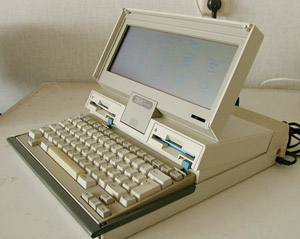IBM PC Convertible

IBM PC Convertible
|
|
| Release date | April 3, 1986 |
|---|---|
| Introductory price | US$2,000 (equivalent to $4,370 in 2016) |
| Operating system | IBM PC DOS with custom icon-oriented shell interface |
| CPU | Intel 80c88 CPU @ 4.77 MHz |
| Memory | 256 kB of RAM (expandable to 640 kB) |
| Storage | Dual 720 kB 3.5" floppy drives |
| Display | Monochrome CGA-compatible LCD screen. |
| Graphics | 80x25 (text), 640x200, and 320x200 |
| Power | Battery: 9.6v/2400mAh (NiCd) Power supply: 15 VDC, 2.7A. |
| Weight | 13 pounds (5.8 kg) |
| Predecessor | IBM Portable Personal Computer |
| Successor | IBM L40 SX (based on the IBM Personal System/2) IBM PS/55 note |
The IBM PC Convertible is the first laptop computer released by IBM. Released on April 3, 1986, the Convertible was also the first IBM computer to use the 3½-inch floppy disk format which went on to become the industry standard. Like modern laptops, it featured power management and the ability to run from batteries.
It was the follow-up to the IBM Portable and was model number 5140. It was replaced in 1991 by the IBM PS/2 L40 SX, and in Japan by the IBM Personal System/55note, which was the predecessor to the ThinkPad.
IBM engineers in 1983 reportedly developed a Tandy Model 100-like laptop, codenamed "Sweetpea", which Don Estridge rejected for not being PC compatible. In 1984 the larger LCD screen of another prototype ("P-14") reportedly failed the "Chiclet rule", especially after the poor reception of the Data General-One's display.
The PC Convertible used the CMOS version of the Intel 8088 CPU running at 4.77 MHz, 256 kB of RAM (expandable to 640 kB), dual 720 kB 3.5" floppy drives, and a monochrome CGA-compatible LCD screen at a price of $2,000. It weighed 13 pounds (5.8 kg) and featured a built-in carrying handle.
The PC Convertible had expansion capabilities through a proprietary ISA bus-based port on the rear of the machine. Extension modules, including a small printer and a video output module, could be snapped into place. The machine could also take an internal modem, but there was no room for an internal hard disk. The concept and the design of the body was made by German industrial designer Richard Sapper.
...
Wikipedia
